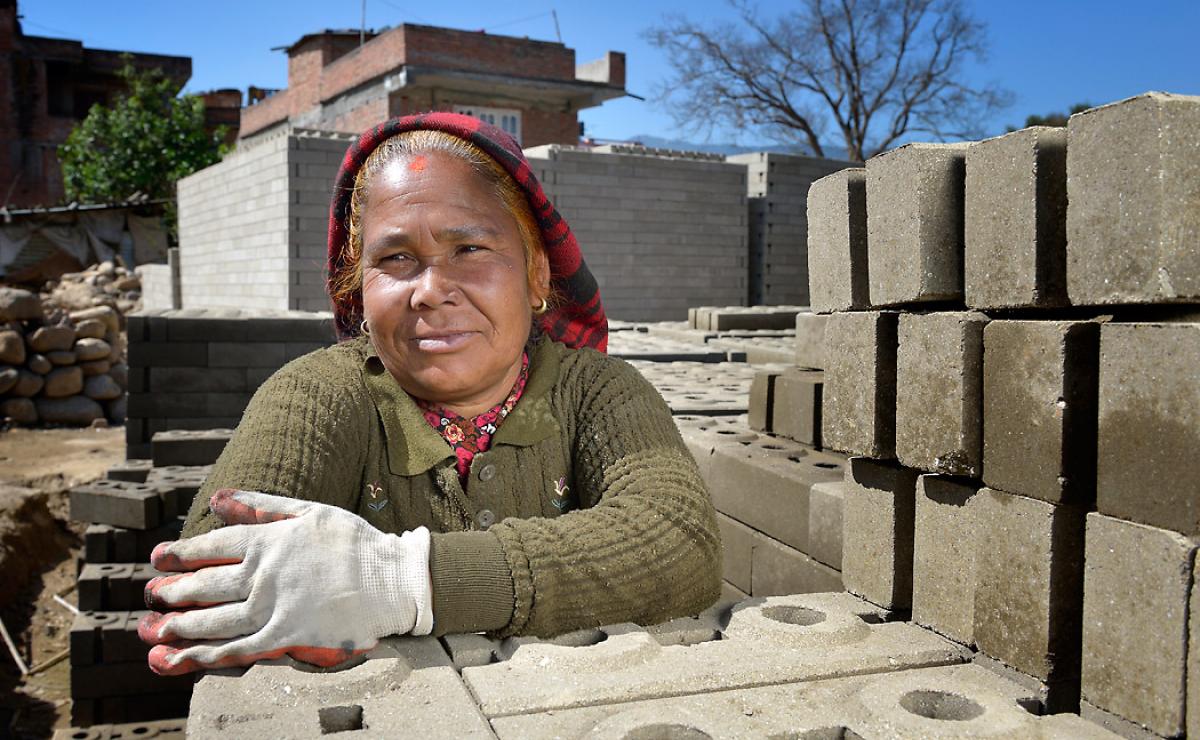Strong women re-building Nepal

“Brave the outside world”
(LWI) - “The earthquake has united us and forced us to brave the outside world and find our strength.” In Nepal women are leading the rebuilding efforts. With the support of the Lutheran World federation (LWF), they have started to speak up and to re-build their homes and lives. It is noon and the sun beats down on the village of Sanogoan, a small Newar settlement at the edge of Kathmandu Valley which after the 2015 earthquake resembles a tented camp. Dust swirls around a group of women, wearing rubber boots beneath their colorful kurtas and pants, with protective shawls wrapped around their heads and waists. They are carrying out a challenging job: compressing large size bricks, made from a mixture of mud, sand and cement. Each brick weighs nine kg and they are stacked to dry in the sun. The women joke with each other and with visitors. They seem strong and united, and more than capable of rebuilding their village.
Say what’s in my heart
One of the women is Kabita Shrestha. “I was told it is dangerous for women to talk to strangers, and used to feel shy and awkward. I was engrossed in my work inside the house and in the fields,” says Kabita, who as a child dropped out of school to take care of her sick mother and younger brother. It is hard to believe that this outgoing 32-year old used to hide in her home when outsiders came to the village.
The earthquake that struck Nepal in April 2015 shook up Kabita’s life, including her identity and role as a single, uneducated woman. Kabita nowadays works a fulltime brick maker, and regularly gives interviews to journalists. “I now feel I want to express everything that goes on inside my heart,” she says.
Kabita is not the only one. Across the country women take up the challenge of rebuilding their lives, meeting challenges and opportunities they have in the wake of the disaster.
Donors believe in women
Most do so out of necessity. In Nepal, according to the 2011 census, 25.7 percent of all households are headed by women. Actual numbers might be higher. The main reason for this is labor migration: Many Nepali men leave the country to work in the Gulf states, Indonesia and Malaysia to be able to support their families. The high incidence of labor migration has literally emptied entire villages of men. Because flights are expensive, they do not come home for years, effectively leaving the women to deal with the problems of everyday life. The present percentage is even higher due to mortality during the earthquake. UN Women estimates that there are approximately 318,000 female-headed households in the 13 worst-affected districts of Nepal.
“Women are taking part in the decision making process around rebuilding. Donors believe in women: they tend to be more responsible. Because of this women’s bargaining power has increased,” says Nani Maya Thapa, Director of Rural Women Creative Forum, a partner organization of LWF Nepal.
Disasters exacerbate inequality
Working in Sindhupalchowk, one of the most affected districts, Thapa’s organization provides cash grants to women to develop small businesses. While most women opt for goat farming, others open a shop, learn tailoring or get involved in vegetable farming. In the LWF supported districts 75 percent of the women are developing their livelihood with the help of such grants. The women are further supported by psycho-social counselling and the rebuilding of community services.
The support is essential for women to be able to deal with their losses. Disasters tend to exacerbate inequalities in society, and Nepal is no exception. Female land ownership is low here, standing at 28 percent before the earthquake. More than a quarter of women don’t have a citizen certificate. As a result they have difficulties in getting a victim ID card which is required to receive government support, and obtaining land and property documents. Women also find it harder to access loans and compensation without the backing of a male guarantor.
After the earthquake, women also suffer from increased gender based violence. “Victims tend not to speak out because they have other priorities but through informal channels we learn that sexual abuse is on the rise against women who live in tents and shelters,” says Thapa, adding that increased alcohol consumption has led to a rise in violence within families, affecting women and children alike.
Out of their comfort zone
LWF Nepal field worker Madhu Suman has been in Sanogoan since May last year and was able to observe the empowerment of the women first hand. “When I first came women hardly spoke in meetings. The earthquake pushed them out of their comfort zone. The women are now quite vocal, and lead the efforts in reconstruction.”
The brick making project in Sanogoan is unique, as across the country women are waiting for government approval and support to start rebuilding their homes. The project is made possible through a partnership between LWF Nepal and Grassroots Movement in Nepal (GMIN), which introduced the technology and has provided the raw materials, training and supervision. Sanogoan has been selected as a Model village by the ACT Alliance. That means that all the services necessary to rebuild the village will be provided by ACT organizations. While LWF leads the reconstructions and brick-making, other partners in the ACT will take care of sanitation needs and psychosocial support.
It is late in the afternoon when the women of Sanogoan finally wrap up their work. “The work is really difficult,” says Purneshwori Shrestha. “Our bodies hurt after the brick making, and there is more work waiting at home. But there is no way back. If we want to rebuild our homes, we must keep going.”
Aim higher
The hard work has paid off: the women produced 80,000 bricks in just three months. Some 200,000 pieces will be enough to build a ground floor for all families but the women aim higher: they plan to build two and a half storey houses.
And there is more to come. “While making bricks we talk about how as a group we can find paid work in future,” says Kabita. “We can work as paid brick makers or masons, or make money in tourism. Some dream of opening a small shop or beauty parlor.”
“The brick makers of Sanogoan show how important it is to put women at the center of disaster response,” says LWF Nepal country director Dr Prabin Manandhar. “Increasing women’s capacity to manage risks and their opportunities for development are fundamental to better prepare for and respond to disasters.”
Contribution by Lucia de Vries, LWF Nepal

